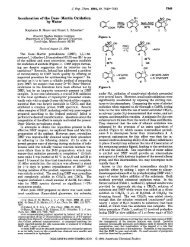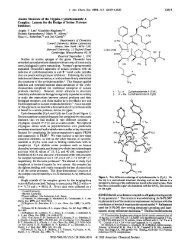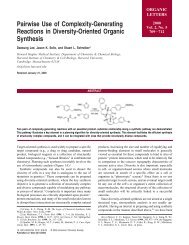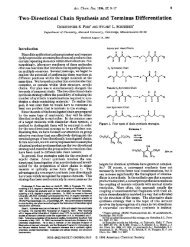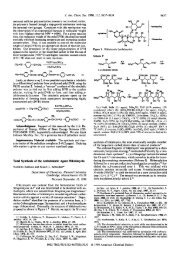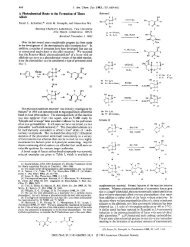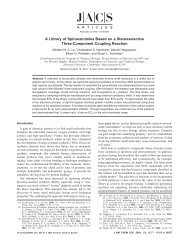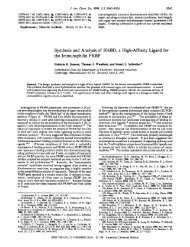Stereochemical Control of the Passerini Reaction - American ...
Stereochemical Control of the Passerini Reaction - American ...
Stereochemical Control of the Passerini Reaction - American ...
You also want an ePaper? Increase the reach of your titles
YUMPU automatically turns print PDFs into web optimized ePapers that Google loves.
acid chelation control with Cu(II)-derived Lewis acids to control<br />
<strong>the</strong> configurational outcome <strong>of</strong> <strong>the</strong> P-3CCR. 8 Importantly,<br />
<strong>the</strong>se conditions are sufficiently mild to be compatible<br />
with a one bead/one stock solution technology platform. 9<br />
Our approach uses a Cu(II) complex and bidentate<br />
coordination with carbonyl substrates as a means to invoke<br />
stereocontrol <strong>of</strong> <strong>the</strong> newly formed C-C bond. Initial studies<br />
used bidentate (S,S)-bis(oxazolinyl) (box) (1 and 2)sCu(II)<br />
and tridentate bis(oxazolinyl)pyridine (pybox) (3 and 4)s<br />
Cu(II) complexes. 8,10 The reactions were performed in <strong>the</strong><br />
presence <strong>of</strong> benzoic acid (5), (benzyloxy)acetaldehyde (6),<br />
and p-methoxyphenyl isocyanide (7) (Table 1). The ligand<br />
screen revealed that bispybox 4, derived from (1S,2R)-<br />
aminoindanol, was able to control <strong>the</strong> R-addition <strong>of</strong> <strong>the</strong><br />
isocyanide with superior enantioselectivity and yield (entry<br />
7, Table 1).<br />
Table 1.<br />
Optimization for <strong>the</strong> Lewis Acid Catalyzed P-3CCR<br />
entry a catalyst b time (h) (0 °C) [conc] (M) % yield c %ee d<br />
1 1a 18 0.25 71 50<br />
2 1b e 18 0.25 63 56<br />
3 2a 14 0.50 93 64<br />
4 2b e 8 0.50 87 63<br />
5 3a 18 0.25 90 85<br />
6 3b e 18 0.25 86 79<br />
7 4 f 18 0.15 93 97<br />
8 g 36 (40 °C) 0.15



